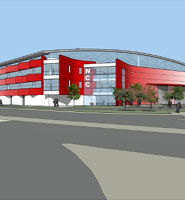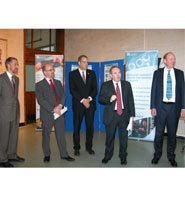The NCC marks a further milestone in the development of a low-carbon economy. It will be an independent, open-access national centre to help deliver world-class innovation in the design and rapid manufacture of composites and enable widespread industrial exploitation.
The Centre will form an international hub, linking activities across all sectors of the UK in research, education and training, technology transfer and incubation of new enterprises.
The state-of-the-art Centre will be supported with £16m of public-sector investment comprising £12m from the Department of Business, Innovation and Skills (the Strategic Investment Fund announced in the last budget) and £4m from the South West Regional Development Agency (SWRDA). Public-sector investment will be supplemented with contributions from some of the world’s leading engineering companies.
The South West was selected as the Centre’s location because the region is one of the most significant developers of, and investors in, carbon-fibre composites, and has some of the most important and advanced end-users and exporters in the country. It is estimated that in excess of £450m has already been committed in composite-related investments (from the public and private sectors) in the region in the last six years.
SWRDA will oversee the construction of a purpose-built, 6,000-square-metre facility with workshop space, open-plan offices, meeting rooms and teaching facilities, in collaboration with the University and industry partners. These ‘First-Tier’ partners currently are Airbus, GKN, Rolls-Royce and Vestas. The Centre will be located in the Bristol area and will be operational by 1 April 2011.
Jim Knight, Regional Minister for the South West, said:
‘The University, in partnership with international partners, has already made great progress in the development of new industries and technologies in the region. For example the Composite Structures Development Centre which is part of National Composites Network based in Airbus at Filton has already developed cutting-edge wing design for the international market.
The region already has a high level skill base in the aerospace sector. By offering the workforce increased training, through in-company training and Train to Gain, we can achieve this exciting skills transfer through this new centre.
I fully support the region's high aspirations for our low-carbon economy and this new centre will go along way in developing and designing light materials across a number of key sectors. This includes green technologies and by bringing our universities and businesses together, the region will continue to be a pathfinder in developing new composite materials in the UK.’Sir Harry Studholme, Chair of the South West RDA, added:
‘This is great news for Bristol, and the South West. Composite materials provide huge opportunities for our industries to develop. They bring new approaches to existing industries to help them remain competitive on an international stage as well as opening up new avenues for developing businesses. As a national centre the NCC will provide a focal point for the research and development of composites. It will build on the strong base the UK already has in this sector, and will provide the opportunities for scientists, technicians and businesses throughout the country to work together.’
Professor Eric Thomas, Vice-Chancellor of the University, said:
‘We are proud to be playing a central role in the establishment of a facility that will be of major significance to south-west England and the UK as a whole. It will reinforce our already close links with industry and yield a range of academic, economic and practical benefits.’

